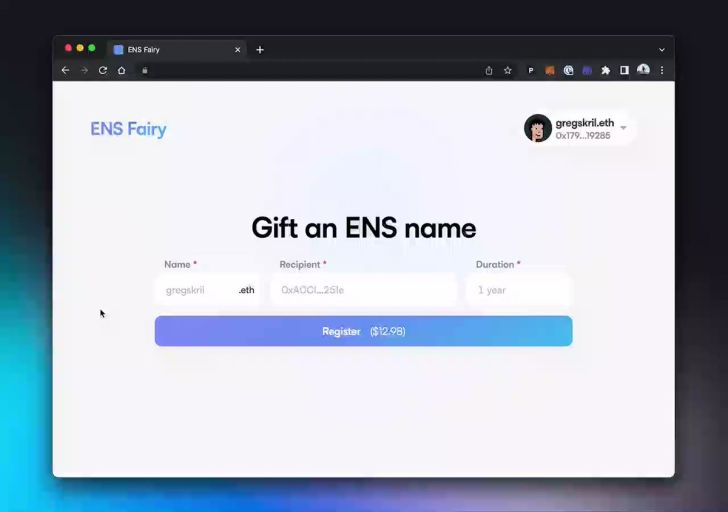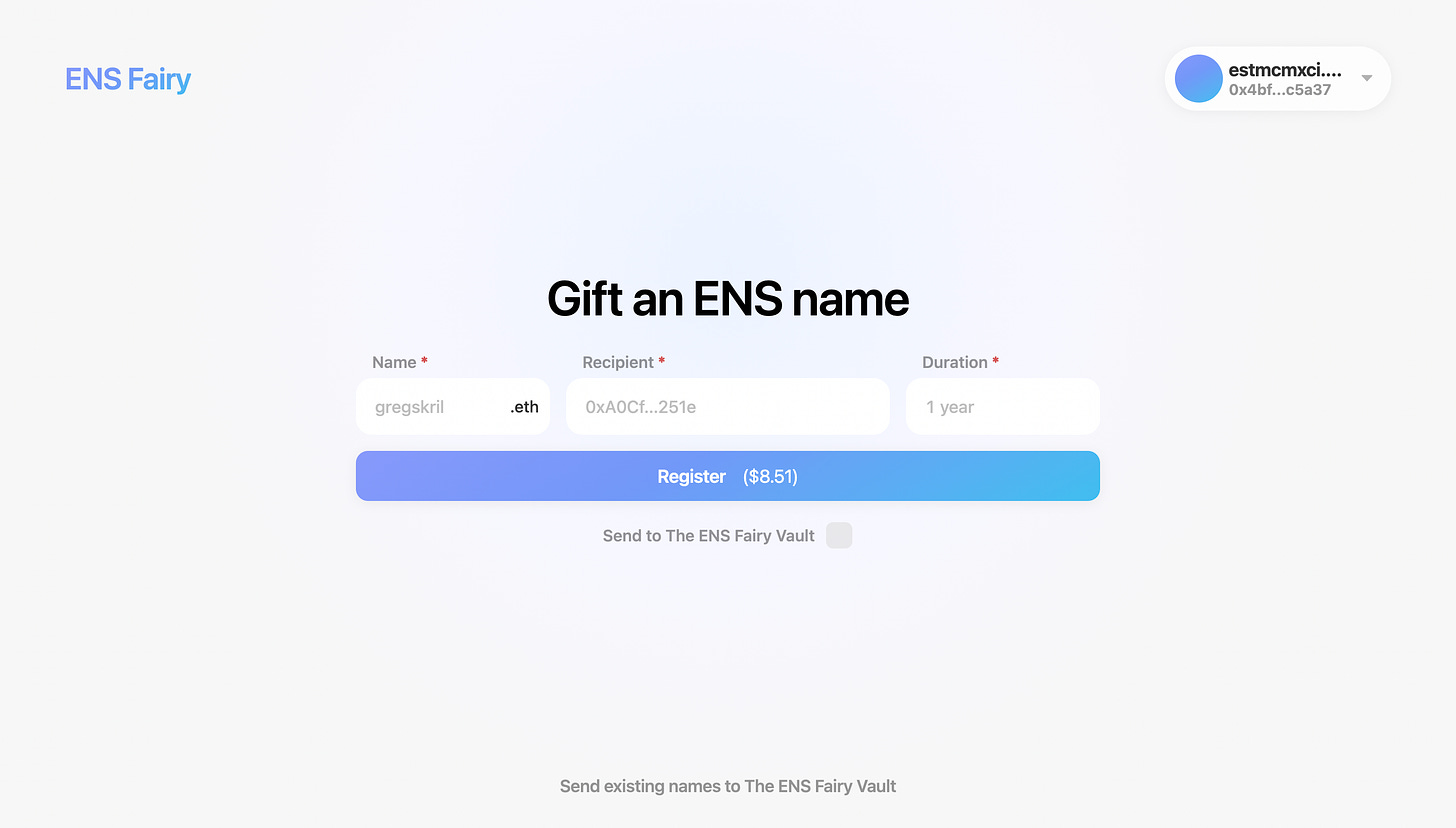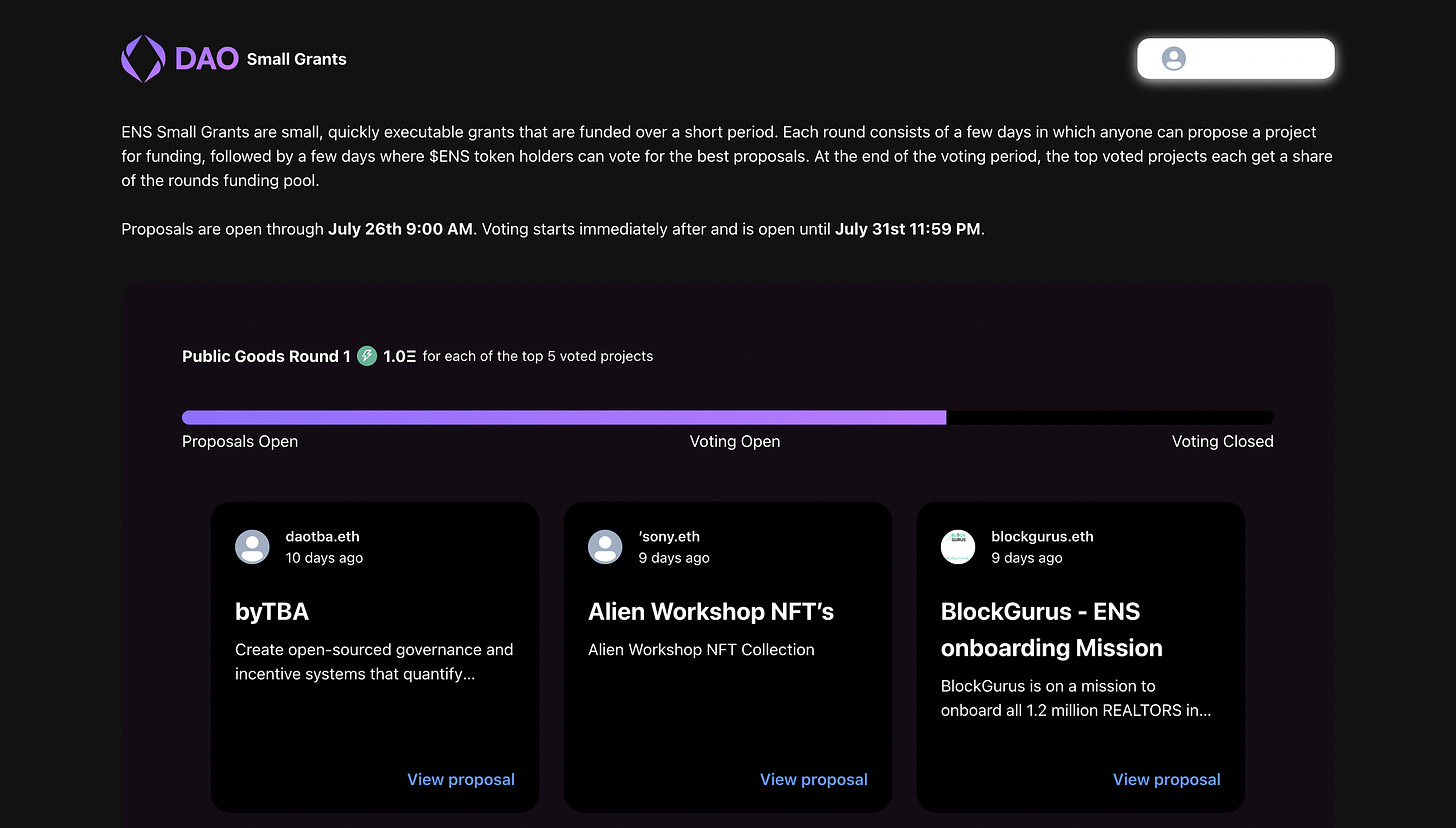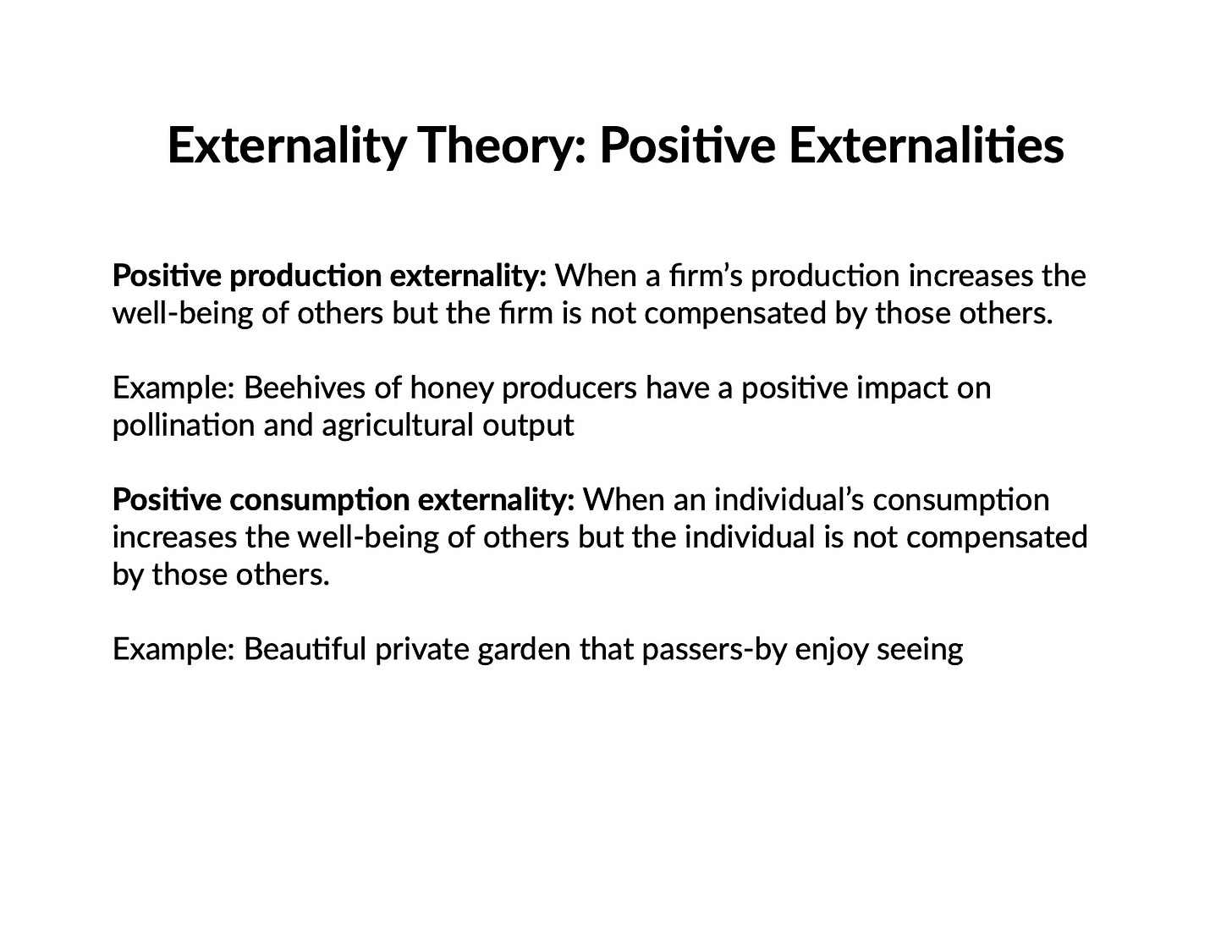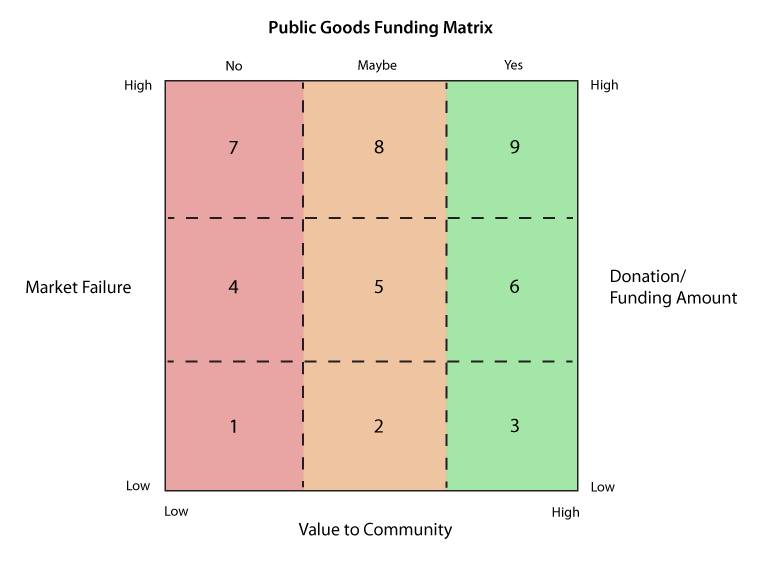Public Goods in the ENS Ecosystem
Fulfilling shared values and achieving Positive Externalities within the ENS Ecosystem
The ENS Fairy site, created by gregskril.eth launched on July 12th, 2022. Developed by a member of the ENS DAO community, it provides a service to either gift or safeguard an ENS Name. Safeguarded names are held in a multi-sig controlled by the nick.eth and validator.eth from True Names Limited.
The goal of the ENS Fairy site is to make ENS registration seamless and intuitive, all the while encouraging pro-social community behavior by enabling altruism. ENS Fairy is an example of a Public Good. This article seeks to define Public Goods as a function of fulfilling community values and demonstrating Positive Externalities.
Intro to Public Goods
Why bother defining Public Goods? This is for the purpose of informing Delegates participating in the recently launched ENS DAO Small Grants what objectives they should be voting in pursuit of. Check out the first batch of proposals by visiting the site. (ensgrants.xyz)
What is a Public Good?
Nobel laureate Paul Samuelson is credited with introducing the concept of Public Goods to contemporary economics. Public Goods have been typically described as having two immutable characteristics; that they are non-excludable and non-rivalrous.
To put it another way, anyone may freely enjoy the benefits a Public Good brings without harming, or limiting access to another. Put thought towards the air you breathe. Breathing comes at no expense to any individual, but is beneficial to all.
Now think about the ENS Fairy site, it is a free service that allows anyone to register and gift an ENS name. Surely this is good. One person’s use of the ENS Fairy site does not come at a detriment to another, and use of the site does not limit anyone else’s accessibility. ENS Fairy fulfills the standard definition of what a Public Good is.
However, I’d like to demonstrate how the ENS Fairy site embodies two other properties of Public Goods that are characterized by user owned and operated networks within Web 3.
What is an ENS Fairy?
After becoming known for registering ENS Domains for several development teams, validator.eth was serendipitously dubbed the ENS Fairy. Several members from the ENS community became familiar with the samaritan for his proactive approach towards ENS flourishing by gifting ENS names. The ENS Fairy is now the support lead of ENS, where they continue to do good.
How did the ENS Fairy site come to be?
The idea for the ENS Fairy site came about through community participation and consensus-building. A member of the ENS Forum noticed that domain squatting may negatively effect the flourishing of ENS Names, thereby hindering mass adoption.
Discussion ensued within the DAO’s Governance Forum, where community participants agreed that creating a multi-sig vault for the purpose of safeguarding ENS names would benefit the ecosystem. Within just a few weeks, the ENS Fairy site went live enabling anyone to either gift an ENS name or donate the name to its vault.
Redefining Public Goods in Web 3
Since its launch, over 200 names have been donated to the ENS Vault including high value names such as stevebalmer.eth and 70 more names have been registered through the site. ENS Fairy has quickly become a community favorite and is becoming a catalyst for ENS flourishing. It is a high impact project that surely deserves continued support from the ENS DAO.

The creator of ENS Fairy site writes:
“I think (Public Goods are) a free and ideally open source tool/resource/content that is useful/entertaining/enjoyed by a group of people within a given ecosystem”
Specific to Web 3, Public Goods merit a re-definition that “should focus on the characteristics that we would like to see the term embody”. In this case, we should expand the definition to include two additional, emergent properties that are unique to Public Goods in the space.
Public Goods Fulfill Community Values
What are the values uniquely expressed in the ENS DAO’s community exchange that led to the creation of the ENS Fairy site? If we have a look at the discussion on the forum we notice a few things:
Attention and Intentionality - community insight led to identifying domain squatting as a possible hindrance towards mainstream adoption
Responsibility and Safekeeping - community sentiment revolved around the intention to safeguard ENS flourishing by encouraging altruism.
Bias Towards Action - the creator proactively built the ENS Fairy site without seeking for anyone’s approval to do so.
In effect, community projects that focus on a purposeful, bottoms-up approach towards implementation are heavily favored within the ENS Community.
ENS Fairy is basically a set of programmed and codified community values; where frENS are encouraged to freely give away ENS names to other frENS. This is in fact the process by which the ENS community fulfills their shared values. Where the creation of a Public Good such as the ENS Fairy site encourages the flourishing of ENS names via altruism.
Insight: Community values are achieved via open-dialogue, consensus building and community participation.
Public Goods Create Positive Externalities
Other Internet argues that Positive Externalities are a natural byproduct of a Public Good; such that wider adoption of that good is beneficial to all.
Furthermore, the flourishing of ENS names through altruism is a positive externality in that creating greater accessibility towards reclaiming one’s own telemetry and privacy via the ENS Protocol is of benefit to all individuals (If you’re interested to learn more about Privacy as a Public Good, check out Ana’s Mirror).
One of ENS’ killer features is that it offers users true ownership of their digital identity in Web 3 thereby allowing users to reclaim their Privacy. Maintaining Privacy in our networked world is as an important matter as ever before.
The more folks that partake within the ENS ecosystem via their .ETH address, the more the public takes back control over their privacy. At scale, this is a Positive Externality of the ENS Fairy site by proxy of ENS flourishing.
Insight: If Privacy is a Public Good, and ENS offers its users ownership of their own identity on Web3, then any product or service that proliferates ENS should be considered a Public Good.
Funding Public Goods
By now, you should have a pretty good idea of what a Public Good is. Now how about funding them? What should be considered when deciding on what projects to fund?
According to the the ENS DAO’s Constitution:
“Any income generated to the ENS treasury is to be used first of all to ensure the long-term viability of ENS, and to fund continuing development and improvement of the ENS system.”
Thus, the ENS DAO should do their best to fund Public Goods that ensure its flourishing, and just as such, proposals made to the ENS DAO should focus on building Public Goods that ensure this flourishing.
Delegates should use discernment and best judgement when voting on proposals via the ENS Small Grants site, they should seek to support the flourishing of ENS through funding ecosystem projects that embody its demonstrated values:
Catalyzing global ENS adoption
ENS Protocol development
Building real world businesses on top of ENS
Proposals that are thoughtful, insightful and have a demonstrative path towards implementation merit more consideration.
Alisha.eth eloquently described two principal characteristics when deciding what projects to fund: risk of market failure and value added to a community. They’ve also provided a framework that helps decide how much funding a Public Good should receive.
The ENS Fairy site is completely free; there are less paths available towards monetization. Therefore, its risk of market failure is high. Yet its impact and value to the ecosystem is obvious. Therefore, a project like ENS Fairy falls towards the right (in green) of the above matrix. Delegates should vote to continue funding the ENS Fairy’s operations, and they should vote to fund other projects like it.
Conclusion
In this article, we covered the genesis of ENS Fairy and how community participation and consensus building led to the community codifying its values as the ENS Fairy Site. We also discussed what Public Goods are within the context of Web 3 and what builders should consider when submitting proposals to the ENS DAO.
Lastly, we covered what Delegates of the ENS DAO should look for when voting on ENS DAO Proposals and how they should determine what proposals to fund.

